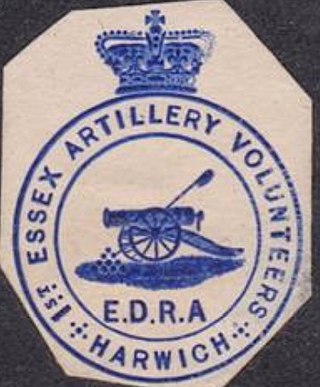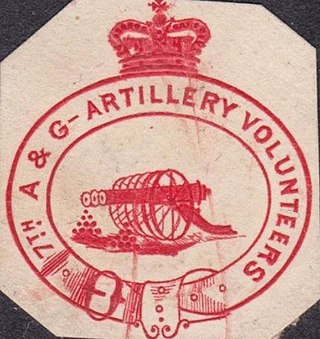
The 1st Lincolnshire Artillery Volunteers were formed in 1860 as a response to a French invasion threat. They fought on the Western Front during World War I. In World War II, the unit took part in the Battle of France and Dunkirk evacuation, the Anglo-Iraqi War with 'Kingcol', the Western Desert Campaign in which it distinguished itself at the Battle of Sidi Rezegh, and finally fought as infantry in the Chindits. The unit was disbanded in 1947.
The 1st Lanarkshire Artillery Volunteers were formed in 1859 as a response to a French invasion threat. Its units fought at Gallipoli and in Palestine during World War I, and in Normandy and North West Europe during World War II. It continued in the postwar Territorial Army until 1961.

The 1st Essex Artillery Volunteers was a unit of Britain's part-time auxiliary forces raised in Essex in 1860 in response to an invasion scare. It served under various designations as field artillery in Palestine during World War I. During World War II its units served as mountain artillery in Italy and as jungle artillery and medium artillery in Burma. Postwar it became an airborne unit until it was merged with other units in the 1950s.

The 1st Devonshire Artillery Volunteers and its successor units served in the British Army's Reserve Forces from 1859 to 1961. During World War I it carried out garrison duty in British India but went on to see active service in the Third Anglo-Afghan War. Converting to an air defence role before World War II its units participated in the Norwegian campaign and the Dunkirk evacuation, the Battle of Britain and then the campaigns in North Africa, Italy, and Burma

The 2nd Cinque Ports Artillery Volunteers was a part-time unit of the British Army's Royal Artillery from 1890 to 1955. Raised as coastal defence artillery, it later served as field artillery in Mesopotamia during the First World War and in the Battle of France and Second Battle of El Alamein during the Second World War. Its successor units later operated as medium artillery in North West Europe, and as jungle artillery in Burma. Postwar, it became an anti-aircraft unit.

The 1st Sussex Artillery Volunteers was a part-time unit of the British Army's Royal Artillery from 1859 to 1961. Raised as coastal defence artillery, the unit later served as field artillery in Mesopotamia during World War I, and in North Africa, Sicily, Italy and North West Europe during World War II. It carried out a number of roles in the postwar Territorial Army.

The 1st Ayrshire and Galloway Artillery Volunteer Corps was formed in 1859 as a response to a French invasion threat. It transferred to the Territorial Force (TF) in 1908 and its successor units fought with the 52nd (Lowland) Infantry Division in Palestine during World War I, and in North West Europe and Burma during World War II. It continued in the Territorial Army (TA) until amalgamation in 1967.

The 115th Field Regiment was a part-time unit of Britain's Royal Artillery (RA), raised as part of the Territorial Army (TA) just before the outbreak of World War II. It served in the Battle of France and the Burma Campaign, and in the postwar TA.

The Edinburgh City Artillery was a part-time unit of Britain's Volunteer Force raised around Edinburgh in 1859. It was the parent unit for a number of batteries in the later Territorial Force, including heavy batteries of the Royal Garrison Artillery that fought on the Western Front during World War I. It later formed a heavy regiment that served in the Battle of France and the campaign in North West Europe during World War II, while a spin-off medium regiment fought in Sicily and Italy. Its successor units continued in the postwar Territorial Army until the 1960s.
The Cheshire Artillery Volunteers was a brigade of Volunteer artillery units raised in the county of Cheshire in the mid-19th century. Their successors served as field artillery in Palestine during World War I and as anti-aircraft (AA) gunners in the Middle East in World War II. They continued in the air defence role in the Territorial Army until 1955.

The 1st Glamorganshire Artillery Volunteers was formed in 1859 in response to a French invasion threat. Raised as a coast artillery unit, it later became part of the Royal Field Artillery in the Territorial Force and served during both World Wars until amalgamated in 1961.

The 1st Monmouthshire Artillery Volunteer Corps was a unit of Britain's Volunteer Force raised in 1860 from Monmouthshire in the Welsh borders. After transfer to the Territorial Force it served with the 53rd (Welsh) Division in Palestine in World War I and in North West Europe in World War II. Its successors serve with today's Army Reserve.
The 1st Forfarshire Artillery Volunteers was a part-time unit of the British Army's Royal Artillery founded in Forfarshire in Scotland in 1859. It served with 51st (Highland) Division through many of the major battles on the Western Front during the First World War. In the Second World War, its regiments saw action in the Battle of France, in the campaigns in North Africa and Sicily, and in North West Europe from D-Day to VE Day. It continued in the postwar Territorial Army until 1975.
The 1st Aberdeenshire Artillery Volunteers was a part-time unit of the British Army raised in Aberdeenshire and neighbouring counties in Scotland in 1860. Its successor units served with 51st (Highland) Division through many of the major battles on the Western Front during the First World War. In the Second World War one of its regiments escaped the surrender of the 51st (Highland) Division in 1940 and went on to serve as heavy artillery in the Italian Campaign. The other regiment served with the reconstituted division at Alamein, in Sicily, Normandy and through North West Europe to the Rhine Crossing and beyond. It served on in the Territorial Army until 1967.
The 1st Renfrew and Dumbarton Artillery Volunteers was a part-time unit of the British Army's Royal Artillery founded in Scotland in 1860. During the First World War, it served with 51st (Highland) Division at the Battle of the Somme before being broken up. In the Second World War, the regiment saw action in the Battle of France, in the campaigns in North Africa, Sicily, Italy, the Greek Civil War and in North West Europe. It continued in the postwar Territorial Army until 1969.

79th (Lowland) Field Regiment was a Royal Artillery (RA) unit of Britain's part-time Territorial Army (TA) during World War II. It was descended from the 1st Ayrshire and Galloway Artillery Volunteers, first raised in Scotland in 1859. It served in Home Forces for most of the war, undergoing training in mountain warfare and air-portable operations before eventually going into action at sea level in the Battle of the Scheldt. It then took part in the fighting in the Rhineland, and then the drive to Bremen. It was reformed in the postwar TA, and continued until 1967.

130th (Lowland) Field Regiment was a Royal Artillery (RA) unit of Britain's part-time Territorial Army (TA) created just before World War II. It was formed from part of 79th (Lowland) Field Regiment, Royal Artillery, itself descended from the 1st Ayrshire and Galloway Artillery Volunteers, first raised in Scotland in 1859. After serving in home defence the new regiment was sent to India where it participated in the First and Second Arakan Offensives, and then in the Burma campaign (1944–1945). It was reformed in the postwar TA and continued in various roles until 1955.

178th Assault Field Regiment, Royal Artillery, was a British Army unit during World War II. Formed as a conventional field artillery regiment in 1942, it was sent to Burma where it was given a range of specialist roles, ranging from operating tracked self-propelled guns to manning light howitzers parachuted into jungle clearings. After the Japanese surrender, it saw action in the Allied Occupation of Java before disbanding in late 1946.

The 51st Field Regiment, was a Royal Artillery unit of Britain's part-time Territorial Army (TA) formed after World War I from a Yeomanry Cavalry regiment recruited in Cumbria. One of its batteries served in the Norwegian campaign at the beginning of World War II. The regiment then sailed to the Middle East and took part in the Western Desert campaign, including the Siege of Tobruk and Operation Crusader. It was next transferred to Ceylon and later formed a Chindit column in the Burma Campaign. The regiment continued in the postwar TA until 1961.

The Manchester Artillery is a Volunteer unit of the British Army first raised in the City of Manchester in 1860, whose successors continue to serve in the Army Reserve today. It became a brigade of the Royal Field Artillery in the Territorial Force in 1908, and in World War I it served in Egypt in 1915–17 before being broken up. Its second line unit went to the Western Front in 1917, seeing action at Ypres, against the German Spring Offensive, and leading the pursuit in the Allies' victorious Hundred Days Offensive. Just before World War II the Manchester Artillery again formed a duplicate. While the parent regiment served in the Battle of France including the Dunkirk evacuation, and later in the Middle East and the Italian campaign, its duplicate fought in Normandy and North West Europe. Both regiments were reformed postwar, but after a number of amalgamations they and several other Manchester-based units were reduced into 209 Battery in the present-day Army Reserve.




















